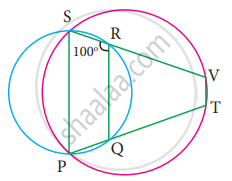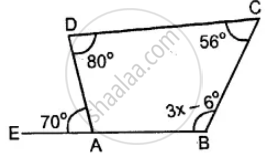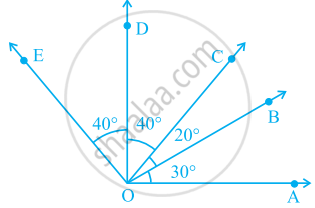Advertisements
Advertisements
Question
In the figure, PQRS and PTVS are two cyclic quadrilaterals, If ∠QRS = 100°, then ∠TVS =
Options
80°
100°
70°
90°
Solution
100°
Explanation;
Hint:
∠SPQ = 180° – 100° ...(Opposite angles of a cyclic quadrilateral PQRS)
= 80°
In the cyclic quadrilateral PVTS,
∠V = 180° – 80° = 100° ...(Opposite angles of a cyclic quadrilateral)
APPEARS IN
RELATED QUESTIONS
In a quadrilateral, define of the following Diagonals .
In a quadrilateral, define of the following Opposite sides .
Complete of the following, so as to make a true statement:
The sum of the angles of a quiadrilateral is .... right angles.
In quadrilateral ABCD, side AB is parallel to side DC. If ∠A : ∠D = 1 : 2 and ∠C : ∠B = 4 : 5
(i) Calculate each angle of the quadrilateral.
(ii) Assign a special name to quadrilateral ABCD
Use the information given in the following figure to find the value of x.

The angles A, B, C and D of a trapezium ABCD are in the ratio 3: 4: 5: 6. Le. ∠A : ∠B : ∠C : ∠D = 3:4: 5 : 6. Find all the angles of the trapezium. Also, name the two sides of this trapezium which are parallel to each other. Give reason for your answer.
If a bicycle wheel has 48 spokes, then the angle between a pair of two consecutive spokes is ______.
In the given figure.
∠AOE is a/an ______ angle
Using the information given, name the right angles in part of figure:
AC ⊥ CD
Investigate :
Use strips and fasteners to make a triangle and a quadrilateral.
Try to push inward at any one vertex of the triangle. Do the same to the quadrilateral. Is the triangle distorted? Is the quadrilateral distorted? Is the triangle rigid?
Why is it that structures like electric towers make use of triangular shapes and not quadrilaterals?
